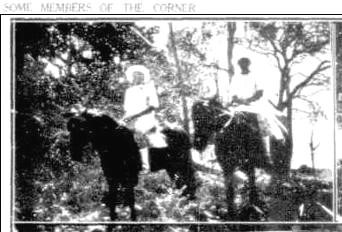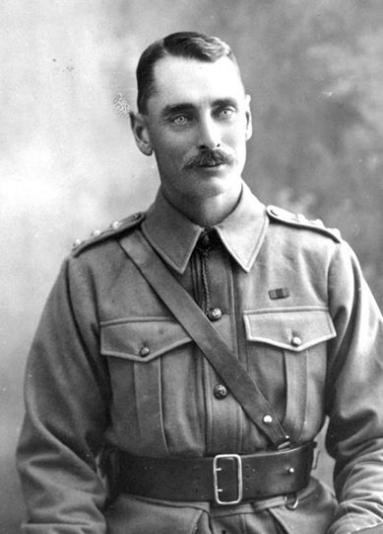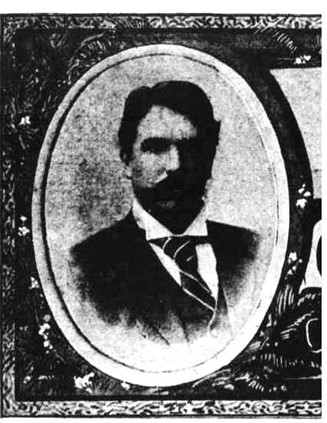Calliope Station

© Janet Lane, 2018. Image: Ethel and Betty Brumby of Calliope Stud Stock Station on their ponies, The Capricornian April 1926.
Note: two Waler ponies were rescued from this area (the Callide Range) when bushfires came through in 2018, see our story about Bay Boy and Grey Boy.
Summary: Good horsemen owned Calliope Station, QLD. It was known as Calliope Stud Stock Station when the Thompsons had it for their cattle and horses. They sold in 1905. Any horses that went wild off there would have been extra good, and there is little to no chance of genetic pollution in modern times.
Lockwood-Grahams, sold 1877. Rogers bought it and there were enough horses there for him to sell a mob to stock Bloomfield station. The Thompsons bought it soon after. Then Wilsons bought it in 1905. Thompsons had super good horses there – top TB lines and draughts from Weinholts (the best in Australia). In 1940 Wilson from Calliope Station had a meeting to get a Light Horse troop together, so they were still horsey then.
From about the year 2000 horses stopped being used on Calliope Station for work as they went completely to mechanisation including helicopters. It had always been a cattle property.
The Thompsons put top quality horses on there, so any that went bush were top sorts. It’s highly unlikely anything went bush off there for many decades as the Wilsons, from 1905, concentrated on cattle, not horses, although had good work horses and the various children there had ponies which seem to be local ponies as no breeding mentioned. Thompson sold horses for India, they were shipped from Gladstone.
The Lockwood-Grahams. Dugald Lockwood was in the Light Horse, (1873 – 1915).
Killed at Quinns Post, Gallipoli 1915. He was carrying wounded people out ignoring his own safety and saved many, Chauvel was good friends with him and respected him hugely. He was a Major, 42 years old when he died, unmarried.

“Major Dugald Lockwood-Graham, a son of a pioneer Queensland squatting family, and the owner of a sugar plantation in that state, was killed in action at the Dardanelles in May when leading a night attack on the enemy’s trenches, says the “Pastoral Review” of the 15th instant. He was one of the finest types of young Australians, and an idea of the feelings with which he was regarded in the army may be seen from extracts from letters written by Lieutenant-colonel Chauvel, Lieutenant-colonel Stodart, and Brig. General Chauvel, First Australian Light Horse brigade. The first-named says: —”He is a great loss to me, both as a friend and a gallant officer, and the gallantry he displayed during the attack was abnormal. For ten minutes he stood exposed to heavy rifle and machine-gun fire, helping wounded back to our own lines, and he is mourned by every officer and man in my command.” Brig. General Chauvel says— “His loss is a serious one to us, as he was one of our finest squadron leaders. In fact, it was because of this that he was elected to organise and carry out a necessary, but hazardous undertaking.”
Image: Major Dugald Lockwood-Graham
He was descended from a very old Queensland squatting family, his grandfather, Mr. Dugald Graham, arriving in Queensland in 1844. He at once purchased Tabragalba Station, in the Logan district, and early in the fifties moved to Wigton Station, in the Burnett. where he died twenty years later. His son, Mr. J. LockwoodGraham. owned for many years Upper Calliope Station, near Gladstone, where his son, the late major, was born in 1873. Mr. Graham bought Ban Ban station, in the Burnett, In 1881, but retired soon after. The late Major Graham was in peace time the Commandant of the Twenty-seventh Queensland Light Horse, and did well in the South African war, serving in the Transvall, Orange River Colony, and Cape Colony. Immediately on the out-break of the present hostilities in August. 1914 he abandoned his sugar plantation and offered his services for the front.”
The Capricornian, 30th Oct 1915.
Calliope Station, Port Curtis.
MR. JAS. THOMSON, Manager.
BY ” GRAPHITE.”
“Thirty miles we travelled westward, over smooth level roads for the first half, past small homesteads nestling among trees, road-side hosteleries, where the inevitable team was at the door; past the camps of railway construction men, and a solitary church on a sharp ridge near by where a stony creek rippled across the roadway and lost itself in a maze of sun-glinted trees. The last half, after we had passed Stowe Station, with its giant date palm and neat out-houses, and the clump of board marking the road to the Boyne Crossing, was much more undulating and picturesque. Out to the N.W. oo a spur beyond Stowe you looked over the Calliope River for 40 miles to the faraway Callide and Dawes Ranges, and the country, auriferous metalliferous and carboniferous, wherein the great coal measures of the Callide lie hid, and where further south the mines of Maxwelton and Mount Rainbow have annually given gold in fair quantities. Adjacent to the road we were travelling are to go the rails to the Callide coal measures, and when a few miles further on we drew up at the curiously named ” Catfish ” Hotel, the pegs of the surveyor were opposite a few feet away. The soil along the whole distance denotes fair grazing land, while here and there, were some good patches of rich alluvium. It was, however, the country on’ the far bank of the Calliope that gave evidence of rich agricultural land in the locality, for, here and there, where some old time flood, sweeping from the far-away ranges, had undermined the bank, the subsequent fall of earth had left bare a great scarf of deep alluvium, which-from the bank to the water’s edge, 20 feet below-gave evidence of its possibilities for the growth of cereals, fruits, etc.
Calliope Station was two miles beyond the hotel thirty miles from Gladstone, the station houses being on a high ridge, which sloped down to the river’s edge half a mile away. Gum, ironbark and bloodwood clothe the1 well-grassed black soil ridges, while on the alluvial flats the Moreton Bav ash flourishes. First owned by a Mr. Clark, the station, afterwards came into the hands of an old-time Toowoomba resident, Mr. Lockwood Graham. In 1S77 it was purchased by Mr. Jas. Thomson, and then went to the Thomson Bros., one of whom, Mr. John Thomson, is the resident manager. As a fattening station for cattle it has always shown its excellence, there being upwards of 2,000 sent away annually to the meat works, or to the Gladstone Butchering Co., of which Mr. Thomson is chief partner. Of one mob of 1,112 head of cattle that was lately sent away, the record is that 144 turned the1 scales at the C.Q.M.E. Cb.’s works, Lake’s Creek, at 1,000’b and over, while the average of all was 908ft). Horse breeding has, however, been taken up very largely during late years, arid now the stud comprises blood horses with highest Australian records and the best of pedigrees, and these, champing, curvetting, all nerves and life, were brought out into the paddock from the stables.
Image: Jas Thomson

Under the cool leaf-shaded veranda their histories, and that of their forbears, were brought forth out of many volumes of that vade-mecum of horse lovers, ” The Australian Turf Register.’
Palmer was the first, a beautiful clear-skinned chestnut with white face and near hind foot. This horse is by Pilgrim’s Progress (imp.) to Victoria by the Hon. Wm. McCulloch in 1892), out of Zeph (bred by Jas. Wilson, Victoria). The record of Palmer is 1-1900, winner of the Third Caufield Futurity Stakes of £2,000, beating. Kinglike, Clean Sweep, and seven other horses of first-class rank. At the same meeting Palmer came first in the Two-year-old Orrong Handicap of (pounds)150, beating twelve others. Palmer is to be used for station breeding purposes, and should produce high-class stock.
Tormentor came next, a splendid upstanding brown horse with face and off hind foot white, and black points. This horse was bred by Mr. John Crozier, St. Albans, Victoria, out of Nightmare, full sister to old Commotion, one of the greatest performers on the Australian turf. Tormentor is half-brother to Mentor, La Tosca, Insomnia, Dreamland, and Monkshood, and was purchased as a yearling for 1,100 guineas, by the late Donald’ Wallace, Victoria. As a sire he has been remarkably successful, his progeny having performed most satisfactorily. Tormentor will be available for the breeders of the district for stud purposes.
The Scamp came third, a fine-looking chestnut with white face. This horse is by The Rake out of Olivia, the latter a well-known performer on the Brisbane turf a few years ago. These three are the chief entires on the station.
Among the blood mares are:-Swift, bay mare by Grand Flaneur out of Banksia (imp.); Destiny, bay mare by Rupert the II., from Mirzapore (imp.); Kalimna, brown mare by Gang Forward, out of Arapile (mp.); Rivulet, bay mare by St. Albans, out of Aurora; Ruby, black mare by Cast-iron, out of Waterwitch; Confusion, bay mare by Gigue (imp.), from Entangled.
A further number of other high-class mares roam about the well-grassed paddocks. Of draught mares there are upwards of 50 on the station, strong well-built animals, putting one in mind of the great haulers of the London and North-Western Railway Company’s road waggons in England.
There is one of the Weinholt Estates Ltd., draught entires on the station, and others are being purchased. A stroll around the home paddock, and the acceptance of the hospitality which has made Queensland stations famous, and then back along the road to that gem of a town on the beautiful harbour of Port Curtis, Gladstone, completed one of the most pleasurable trips that it has been my lot to experience.
That the stock held by the Thomson Bros, will make a wonderful improvement in horse breeding in the district there is no gainsaying, and with the well-grassed and well watered country that the district is favoured with, the breeding of remounts for the Indian, and we would assume, the English service should become one of the most prominent occupations in the district.”
Queensland Country Life, 1st October 1901.
James Lochie Wilson (1880-1956) with McDouall bought Calliope Station in 1905. Wilson married McDouall’s daughter. He had served in Boer War. Then WW1 in Infantry. The partnership bought several other stations. Wilson was on various agricultural boards and the harbour board. Cattle people, not horse breeders; although in current times do pleasure riding/western competition.
They do not use horses to muster, they use helicopters and vehicles. Same Wilson family there.
Before they went to machinery, the Wilson’s employed a good horseman – now retired in Gladstone and worth interviewing, Norman Hunter. Here is an interview with him – so there were good cattle horses there until a few years back…
https://www.chinchillanews.com.au/news/stockman-hangs-up-hat-after-55-years-in-the-saddle/3019376/
The current Wilsons do western riding for pleasure/competition
http://www.abc.net.au/news/2014-10-24/working-cow-horse-in-central-queensland/5832398